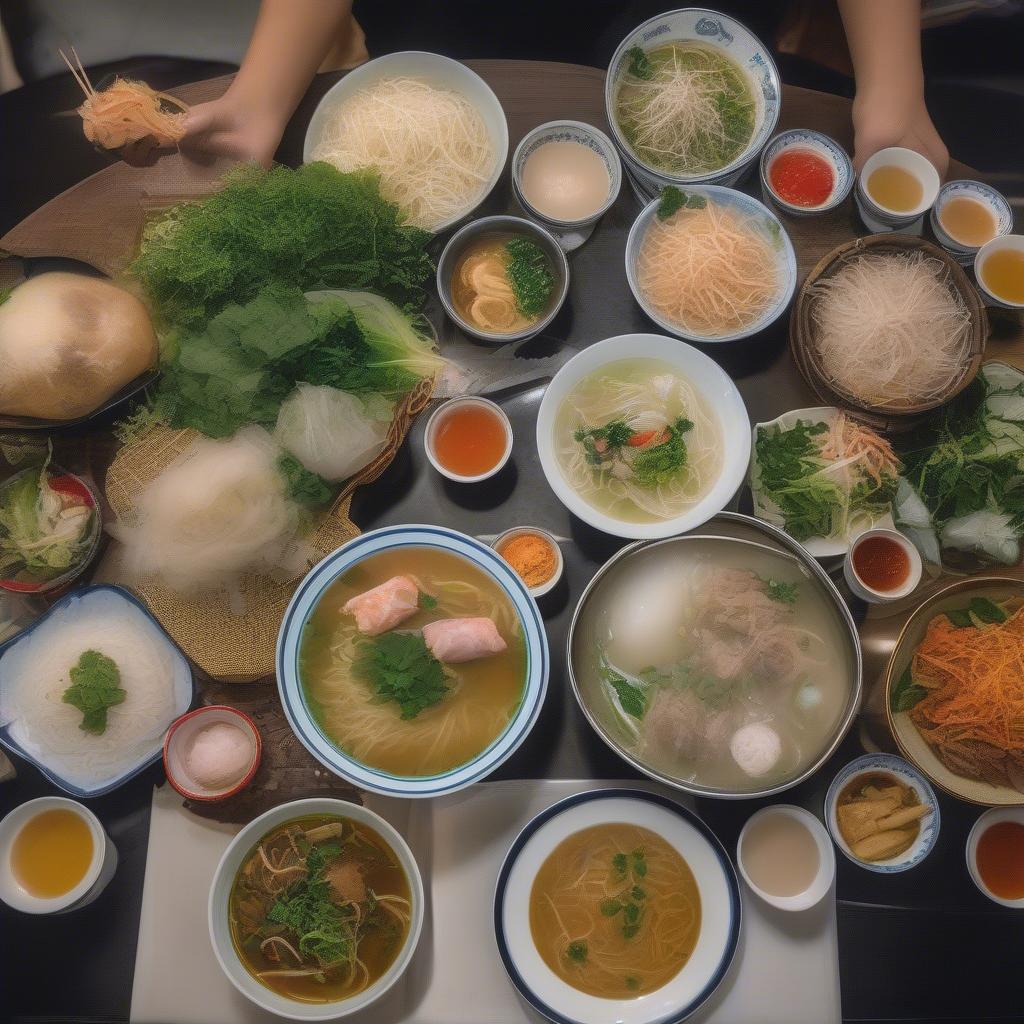
To the casual visitor, the province of Nam Dinh flies under the radar. Situated in the Red River Delta, Nam Dinh is known for agricultural areas and beautiful churches. Tran Hung Dao, the 13th-century national hero who helped defeat invading Mongol hordes, came from these parts. But Nam Dinh’s most significant contribution to Vietnam is the beef noodle soup, phở bò.

Legends and myths mean that many histories in Vietnam are coloured a variety of shades. This is also the case with phở, the country’s most famous dish, and its most successful culinary export. In the capital city of Hanoi, phở is a staple breakfast dish.
A bowl of pho bo in Hanoi. Traditionally the broth would be simmered for up to 65 hours
From the early hours, phở stalls set up shop along the sidewalks. Shrouded in clouds of steam, the cook will assemble each bowl to order. Boiling broth is poured over a bed of soft rice noodles and sliced meat, and topped with a handful of chopped herbs and chives. Each diner will customise their bowl to taste, with squeezes of lemon, slices of red chili, sprigs of basil, and dabs of hoisin sauce. It’s an experience no visit to Vietnam is complete without.
While Nam Dinh is believed to be the geographical cradle of phở, few would dispute that its spiritual home is Hanoi. It was Hanoi’s intersection of historical and cultural factors made phở popular.
The history of phở begins at the end of the 19th century, at the peak of French colonialism. French demand led to a greater availability of beef in Vietnam. This in turn produced a surplus of beef bones, which were used by Chinese and Vietnamese vendors to deepen and perfect the flavour of the Nam Dinh broth.
A man makes fresh rice noodles for pho at a small house near Bat Dan street in Hanoi

Over the years, phở gained traction in Hanoi. It evolved from a noodle soup called xáo trâu — a simple dish made with slices of water buffalo meat cooked in broth with rice vermicelli — into a delicate and balanced creation. Buffalo meat was swapped with beef, round rice noodles were added, the flavour of the broth was refined, and the classic Hanoi phở was perfected.
Migrant workers from the Chinese provinces of Yunnan and Guangdong loved the new take, due to its similarity to dishes from back home. The Vietnamese, having developed a taste for beef, grew equally enamoured. By the 1930s, gánh phở — roaming vendors shouldering mobile kitchens on bamboo poles — had become a common sight in the streets of the Old Quarter.
A sign for a small street stall selling pho ga, the chicken version of the dish
Since then phở has been entwined with the national psyche. In his poem “An Ode to Pho,” poet Tu Mo celebrated the subtle flavour of the soup and its egalitarianism: it is a dish loved by both rich and poor.
Like Vietnam itself, phở has undergone impactful changes. Privation during hard times resulted in meagre bowls of soup hitting the streets. The most divisive shake up occurred when phở moved south along with millions of northerners following the partition of the country in 1954.
A woman makes chicken pho at her stall at Quan An Ngon restaurant in Hanoi
Unshackled in this southern land of plenty, chefs started sweetening their broth and accessorising with an array of herbs as well as additions such as hoisin and chili sauce. The “broth-off” continues to this day. The main difference is the extra fixings of the southern version. Phở purists swear by the simpler Hanoi phở, however both versions are delicious.
While debate rages as to the location of Vietnam’s best pho, it could be argued that the dish hasn’t actually evolved all that radically since the early years. Different cuts of meat have been brought to the table and diners can choose from a range of beef cuts including rare beef (tái), flank (nạm), brisket (gầu), tripe (sách), tendon (gan) and meatballs (bò viên). The invention of chicken phở (phở gà) in 1939 caused ructions for a while. But, by and large, pho has stayed true to its original tenets.
Pho is widely sold around Vietnam for one to two dollars a bowl
That said, phở is not an immovable feast. Some young chefs in Vietnam are experimenting with items such as brown rice noodles and fresh pho noodle rolls. In 2018, Anan Saigon famously introduced a 100$ phở with truffle oil, wagyu and foie gras. And overseas, chefs are getting even more inventive with additions such as crawfish and sous vide beef.
These days, beef bones, flank steak oxtails, charred onion, charred ginger and spices including star anise, cinnamon, cloves, black cardamom and coriander are used to make the slow-cooked broth. Chicken phở is an equally popular alternative to the original. In the north, garnishes are limited to fresh chilli slices, lemon, and a few herbs; but in the south, the phở is noticeably sweeter and there’s a wide array of types to choose from. In Central Vietnam, you can even find phở with poached eggs.
As one of the world’s classic noodle dishes, pho has more than earned its right to respect.
